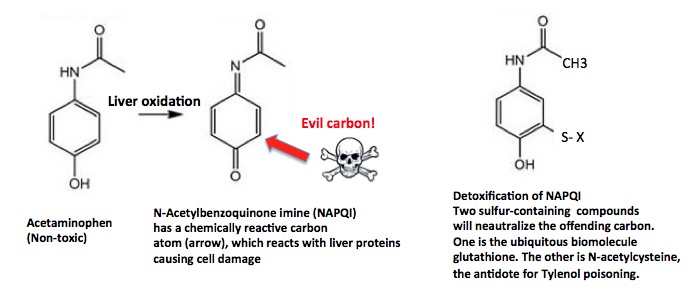If you own Johnson and Johnson stock you probably have enough problems on your hands. The company keeps getting hammered by lawsuits alleging that talc in baby powder has given women cancer (1). So you sure don't need me smacking down Tylenol, which had worldwide sales of almost $2 billion in 2016.
But, don't blame me. This is not my quote. It's part of a written interview I did back in July with Aric Hausknecht, M.D, "Pain In The Time Of Opioid Denial: An Interview With Aric Hausknecht, M.D."
"Tylenol Is By Far The Most Dangerous Drug Ever Made"
Aric Hausknecht, M.D. July 30, 2017
Why would Dr. Hausknecht, a New York neurologist and pain management specialist, say this? Taken out of context, such a sweeping statement may seem to be hyperbolic. The most dangerous drug ever made? I asked him to elaborate. He did:
"Each year a substantial number of Americans experience intentional and unintentional Tylenol (acetaminophen) associated overdoses that can result in serious morbidity and mortality. Analysis of national databases show that acetaminophen-associated overdoses account for about 50,000 emergency room visits and 25,000 hospitalizations yearly. Acetaminophen is the nation's leading cause of acute liver failure, according to data from an ongoing study funded by the National Institutes for Health. Analysis of national mortality files shows about 450 deaths occur each year from acetaminophen-associated overdoses; 100 of these are unintentional."
Therapeutic Index - A cornerstone of pharmacology
When evaluating drug toxicity, a critical parameter is called the therapeutic index (TI). The TI is the ratio of the toxic dose to the effective dose. Obviously, the higher the TI the better, since the greater the separation of the therapeutic and toxic doses, the less likely an overdose. Here are some examples of low TI drugs:
- Lithium (bipolar disorder)
- Warfarin (blood thinner)
- Theophylline (asthma)
- Digoxin (various heart conditions)
And some examples of high TI drugs:
- Benadryl (diphenhydramine, antihistamine, sleep aid)
- Valium (sedative, hypnotic) (2)
- Neurontin (gabapentin, restless leg syndrome, multiple off-label neurological indications)
Tylenol (acetaminophen) an analgesic (pain reliever) gets a free pass in the minds of many people because it doesn't come with the liabilities of the NSAIDs, such as aspirin and ibuprofen - bleeding, heartburn, kidney toxicity, ulcers, and salicylate allergy. The absence of gastrointestinal toxicity is responsible for the widespread perception that Tylenol is safer. In some ways it is, but in others, it is not. It may leave your stomach alone, but not your liver.
Dr. Hausknecht's statistics may seem puzzling. How can there be 50,000 emergency room visits and 25,000 hospitalizations, yet only 450 deaths per year? This is because, when treated in time, irreversible liver damage from an acute overdose of acetaminophen can be prevented. There is an antidote called N-acetylcysteine. But the danger of the drug is not only from acute doses. Both acute and chronic use of acetaminophen can lead to permanent liver damage, not because acetaminophen itself is toxic, but because the liver converts it into something that is (Figure 1), sealing its own fate in the process. (Apologies for the biochemistry.)

Figure 1: Metabolic activation and detoxification of acetaminophen. Oxidation by liver enzymes forms N-acetylbenzoquinoneimine, a chemically reactive, toxic molecule. The carbon atom (red arrow) irreversibly "attacks" various proteins in the liver. The antidote, N-acetylcysteine sops up (deactivates) the benzoquinone imine, but only if given in time. It does not reverse liver damage.
So, what is the therapeutic index for Tylenol? You may be rather surprised. Before 2011 the maximum daily dose of acetaminophen recommenced by the FDA was 4,000 mg. It is now 3,000 mg. The estimated lethal dose of the drug is 10 grams in one day, which is not terribly different from the maximum daily dose. The TI is thus about 3, which is pretty bad, especially compared to other drugs which are perceived as far more dangerous:
References:
a) http://www.acutetox.eu/pdf_human_short/1-Acetaminophen%20revised.pdf
b) https://medlineplus.gov/ency/article/002542.htm
c) https://www.fda.gov/ohrms/dockets/dailys/03/Aug03/082903/03p-0398-cp0000...att-6-vol1.pdf
d) https://www.ncbi.nlm.nih.gov/pubmed/357765
** Therapeutic index (TI) is an approximate, but indicative measure of the likelihood of a toxic or lethal overdose. It is not a measure of absolute toxicity, rather, the safety margin between therapeutic and toxic or lethal doses.
Approximate therapeutic indexes for some common drugs. The higher the TI, the lower probability of an overdose.
Rather interesting that the CDC, which has inserted itself firmly up your doctor's anus for writing scripts for Valium or hydrocodone, is only too happy to recommend that pain patients take a drug that is more likely to cause an overdose than either of them.
"Several nonopioid pharmacologic therapies (including acetaminophen, NSAIDs, and selected antidepressants and anticonvulsants) are effective for chronic pain. In particular, acetaminophen and NSAIDs can be useful for arthritis and low back pain..."
CDC Guideline for Prescribing Opioids for Chronic Pain — United States, 2016
Next: "So, Tylenol isn't that safe, but at least it works, right?"
NOTES:
(1) It would seem that evidence of harm is totally irrelevant in the courtroom. It is far from clear that talc is harmful. But it is even further from clear that there is *any* proof that Eva Echeverria, a victim of ovarian cancer who used baby powder her whole life, contracted the disease from the powder. Lawyers 1, Science 0.
(2) It is very difficult to die from a Valium overdose in the absence of alcohol, opioids or other central nervous system depressants. (See: "Can Valium Kill You?"). In two case studies, people survived overdoses of 500 and 2,000 mg (50 and 400 five milligram pills, respectively). But, 50 regular strength Tylenol pills (16.25 g) is approximately twice the estimated lethal dose. Yes, a single dose of 500 Valium pills is less dangerous than 50 Tylenol pills.




